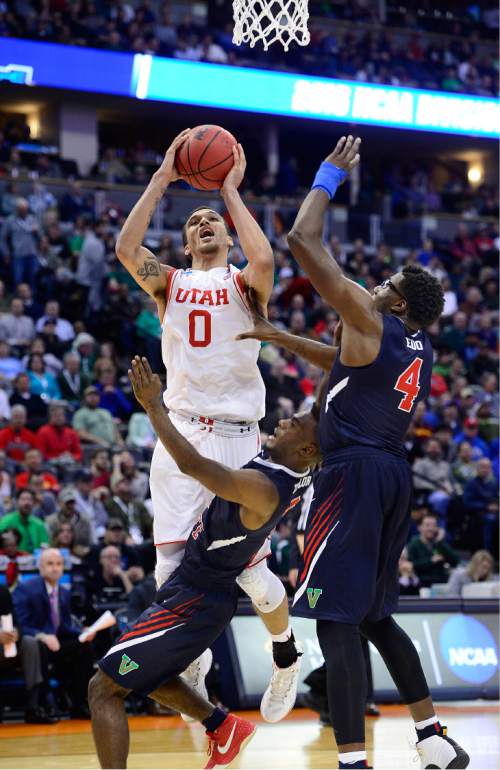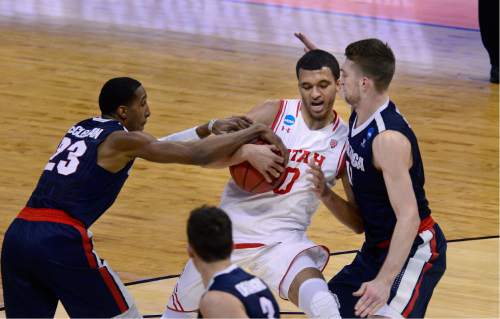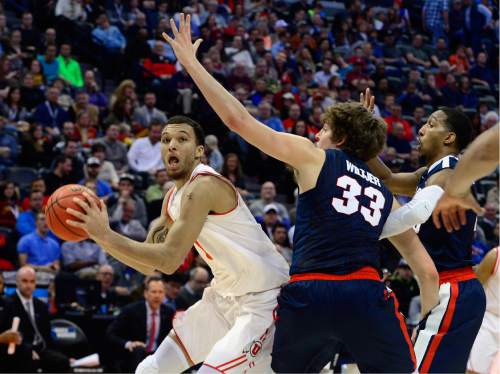This is an archived article that was published on sltrib.com in 2016, and information in the article may be outdated. It is provided only for personal research purposes and may not be reprinted.
Sophomore forward Brekkott Chapman's recently announced transfer from Utah brought up, one more time, a ridiculous, hypocritical NCAA policy that has been talked about being changed, has been thought of by many as needing to be changed, but that, so far, has stayed the same.
NCAA rules generally require college basketball and football players to sit out a season, losing a year of eligibility, when they transfer to a school within the same division. In some cases, conferences lay an extra penalty of an additional year on a student-athlete if he wants to transfer to a school inside the same league. Graduated players are permitted to transfer without sitting, and some coaches and administrators are pitching a fit over that. Moreover, coaches sometimes place restrictions on transfers, blocking them from moving to certain schools.
Shame on them. Shame on that.
Here's no big surprise: The whole restrictive setup gives most of the power to coaches and institutions at the expense of individuals who should be allowed, if a situation is unsuitable to them, to move on, free of restrictions.
Coaches can move on, and coach immediately, if they have a bigger, better, richer opportunity elsewhere. Why should student-athletes have hurdles put in their way, should they see their own reasons, whatever they are, to transfer? If they want more playing time, if they want to get away from a coach who wasn't what they thought he was, if they want to be closer to home, if they want to be where their girlfriend is, if they want a change of scenery — whatever they want — why should coaches have any say about where athletes go?
They shouldn't.
Apologists/fans of coaches and their programs, and the coaches themselves, will say they are damaged when a student-athlete who has been recruited and signed to play at a school leaves, that they should be bound by their commitment and if they break it, there should be resultant blockages/penalties.
Those same people, though, do not take umbrage when coaches run players off, the same players to whom coaches made all kinds of promises in the recruiting process, and then want to toss them aside when they don't meet certain expectations. It's good one direction, but not the other. Many athletic scholarships are given on an annual basis, not for four years, and are renewed — or not renewed — each year. There now are multiyear scholarships, a move that has gained momentum, but even those are subject to review and can be "non-renewed" for subjective reasons.
Advantage, again, coaches and institutions.
During a press conference this past week, UTEP basketball coach Tim Floyd bemoaned a growing trend of transfers in the college game, blaming a generation of players who want immediate satisfaction with their circumstances.
One of the stats Floyd noted was that some 40 percent of college basketball players transfer by the end of their sophomore seasons, a number substantiated by the NCAA. Among all students, a third transfer. Across all sports, the transfer percentage is lower than the general population.
"We have such a massive number of kids that transfer nowadays because of everybody wanting instant gratification," North Carolina coach Roy Williams recently told the Associated Press. "Coaches in some way have been blamed for that. We have absolutely nothing to do with it. It's the want and need of instant gratification. The culture we have, if things don't work out, just leave and go somewhere else."
That's a problem for the coaches and schools to deal with, and it is a headache. But it's not on the same level of violation as American universities restricting student-athletes who may have made a mistake signing with a certain coach, a certain program, and who want to correct it by moving to a better situation. Williams' claim that transferring is always attributable to "instant gratification" on the part of a player is an assumption that is far from always being true.
When Larry Bird transferred from Indiana to Indiana State, it was a good move for him. When Chapman transfers from Utah to wherever he ends up, it might be a good move for him. In that case, Larry Krystkowiak should have no say in where Chapman goes. As is with every college basketball or football player, it's their life, their chance to play college sports, they should be able to go where they want to go, without interference from any coach or any institution.
Administrators/coaches/apologists/fans will say otherwise because their top concern is for their team, their program. They'll talk about accountability and responsibility and binding deals, and such. They'll talk about professional contracts and non-competes. They'll talk about protecting their collective interests, which, in the case of many coaches begins and ends with their own hides. They'll talk about rival coaches poaching their players, interfering with other people's business and sticking their noses where they don't belong.
What they'll ignore is the tampering that administrators do when they hire other school's coaches. More importantly, they'll ignore the welfare of the student-athletes involved, a priority that should come first, even if it is inconvenient or objectionable to the hypocritical powers that be. Whether a kid's reason for leaving is "instant gratification" or playing time or something more personal and profound, let him go, if he wants to go, without restriction.
Let him go.
It is America, land of the free, right?
The NCAA should hurry it up and change their transfer rules, letting coaches deal with holding onto their own players and getting replacements if they must, and allowing players to play where they want to play, to go where they want to go when they want to go.
After all, that's what coaches do.
GORDON MONSON hosts "The Big Show" with Spence Checketts weekdays from 3-7 p.m. on 97.5 FM and 1280 AM The Zone. Twitter: @GordonMonson.







